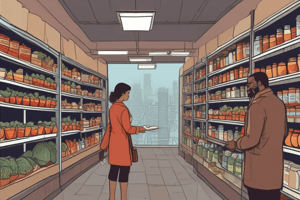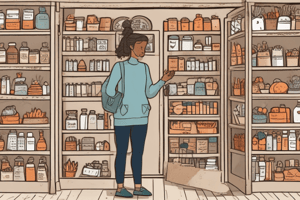Podcast
Questions and Answers
What defines a food desert?
What defines a food desert?
- Geographic areas lacking affordable and healthful food (correct)
- Areas with abundant access to fresh produce
- Urban areas with multiple grocery stores
- Regions with high density of fast food restaurants
Which of the following factors contributes to the existence of food deserts?
Which of the following factors contributes to the existence of food deserts?
- Low levels of population density
- Greater availability of convenience foods compared to fresh food (correct)
- High consumption of organic foods
- Increased number of supermarkets in the area
What demographic is most affected by food deserts?
What demographic is most affected by food deserts?
- Children in high-income households
- Wealthy individuals in urban areas
- Minority and low-income populations (correct)
- Adults with stable employment
Which of the following is NOT a sign of poor food quality in children?
Which of the following is NOT a sign of poor food quality in children?
What are the primary characteristics of ultra-processed foods?
What are the primary characteristics of ultra-processed foods?
What percentage of food ads on children's shows is devoted to candy and snacks?
What percentage of food ads on children's shows is devoted to candy and snacks?
Which of the following is NOT identified as a driver of climate change in the food industry?
Which of the following is NOT identified as a driver of climate change in the food industry?
What is one recommended step individuals can take to improve their nutrition?
What is one recommended step individuals can take to improve their nutrition?
Which food item represents the smallest percentage of ad time in children's shows?
Which food item represents the smallest percentage of ad time in children's shows?
What should you prefer to drink instead of packaged beverages?
What should you prefer to drink instead of packaged beverages?
What is food insecurity primarily defined as?
What is food insecurity primarily defined as?
Which of the following chronic conditions can be caused by food insecurity in adults?
Which of the following chronic conditions can be caused by food insecurity in adults?
Which of the following is NOT a consequence of food insecurity on children?
Which of the following is NOT a consequence of food insecurity on children?
What are social determinants of health?
What are social determinants of health?
How does the food environment affect food choices in the US?
How does the food environment affect food choices in the US?
Which of the following best describes a food swamp?
Which of the following best describes a food swamp?
What is a key outcome of addressing social determinants of health?
What is a key outcome of addressing social determinants of health?
What is a primary reason people choose ultra processed foods?
What is a primary reason people choose ultra processed foods?
How do artificial additives in food influence brain function?
How do artificial additives in food influence brain function?
What is one effect of consuming highly palatable processed foods?
What is one effect of consuming highly palatable processed foods?
Which term describes the appeal of food based on its texture and taste dynamics?
Which term describes the appeal of food based on its texture and taste dynamics?
What do PET scans reveal about the brains of those who consume a lot of sugar and fat?
What do PET scans reveal about the brains of those who consume a lot of sugar and fat?
What is one of the key components of food engineering aimed at consumer addiction?
What is one of the key components of food engineering aimed at consumer addiction?
What is NOT a recognized diagnosis for overeating behaviors?
What is NOT a recognized diagnosis for overeating behaviors?
What happens as people develop a tolerance to sugar?
What happens as people develop a tolerance to sugar?
What is one of the primary impacts of sugar on the brain?
What is one of the primary impacts of sugar on the brain?
How do Big Food Corporations affect public health policies?
How do Big Food Corporations affect public health policies?
What is a significant downside of food policy making?
What is a significant downside of food policy making?
What influence does television viewing have on children's eating habits?
What influence does television viewing have on children's eating habits?
What is a common practice among Big Food Corporations regarding health studies?
What is a common practice among Big Food Corporations regarding health studies?
What is a behavioral response often observed in individuals addicted to sugar?
What is a behavioral response often observed in individuals addicted to sugar?
What effect does advertising typically have on food choices, particularly for children?
What effect does advertising typically have on food choices, particularly for children?
What is one of the main strategies used by food policy makers in health promotion?
What is one of the main strategies used by food policy makers in health promotion?
Flashcards
Food Desert
Food Desert
A geographic area with limited access to affordable, fresh, and healthy food options.
Food Oasis
Food Oasis
An area with abundant access to supermarkets and various food shops.
Food Swamp
Food Swamp
A place with a large number of cheap, unhealthy food options available, making healthy choices difficult.
Childhood Poor Nutrition Signs
Childhood Poor Nutrition Signs
Signup and view all the flashcards
Processed Foods Impact
Processed Foods Impact
Signup and view all the flashcards
Food Insecurity
Food Insecurity
Signup and view all the flashcards
Cycle of Food Insecurity & Chronic Disease
Cycle of Food Insecurity & Chronic Disease
Signup and view all the flashcards
Impact of Food Insecurity on Adults
Impact of Food Insecurity on Adults
Signup and view all the flashcards
Impact of Food Insecurity on Children
Impact of Food Insecurity on Children
Signup and view all the flashcards
Social Determinants of Health
Social Determinants of Health
Signup and view all the flashcards
Food Environment
Food Environment
Signup and view all the flashcards
Food Ads on Children's TV
Food Ads on Children's TV
Signup and view all the flashcards
Big Food's Environmental Impact
Big Food's Environmental Impact
Signup and view all the flashcards
Food System Influence
Food System Influence
Signup and view all the flashcards
Take Control of Your Food
Take Control of Your Food
Signup and view all the flashcards
Nutrient-Dense Foods
Nutrient-Dense Foods
Signup and view all the flashcards
Ultra-Processed Foods
Ultra-Processed Foods
Signup and view all the flashcards
Food Engineering
Food Engineering
Signup and view all the flashcards
Dopamine & Food Addiction
Dopamine & Food Addiction
Signup and view all the flashcards
Food Engineering & Brain
Food Engineering & Brain
Signup and view all the flashcards
Food Engineering & Weight
Food Engineering & Weight
Signup and view all the flashcards
Naltrexone and Food Addiction
Naltrexone and Food Addiction
Signup and view all the flashcards
Sugar Tolerance
Sugar Tolerance
Signup and view all the flashcards
Sugar's Role in the Brain
Sugar's Role in the Brain
Signup and view all the flashcards
Food Policy's Focus
Food Policy's Focus
Signup and view all the flashcards
Big Food's Influence on Policy
Big Food's Influence on Policy
Signup and view all the flashcards
Big Food's Business Practices
Big Food's Business Practices
Signup and view all the flashcards
Advertising's Role in Food Choices
Advertising's Role in Food Choices
Signup and view all the flashcards
Impact of Advertising on Children
Impact of Advertising on Children
Signup and view all the flashcards
The Dopamine Loop
The Dopamine Loop
Signup and view all the flashcards
The Public Health Dilemma
The Public Health Dilemma
Signup and view all the flashcards
Study Notes
Food Insecurity & Public Health
- Food insecurity is the inability of a household to provide enough food for all members to live healthy lives, encompassing both a lack of food and a lack of healthy, nutritious food in sufficient quantities.
- Food insecurity is cyclical, with chronic disease stemming from food insecurity, further reducing access to food and nutrition.
Impact on Adults
- Food insecurity can lead to various health issues, including:
- Cancer
- Heart disease
- Diabetes
- Functional limitations
- High blood lipids
- High blood pressure
- Obesity
Impact on Children
- Food insecurity negatively impacts children's well-being, resulting in:
- Behavioral and social-emotional problems
- Poorer developmental outcomes
- Iron deficiency anemia
- Frequent stomach problems
- Headaches
- Poorer educational performance and academic outcomes
- Lower overall health-related quality of life
Social Determinants of Health
- Social determinants of health—factors impacting health originating from where individuals are born, grow, live, work, and age—include socioeconomic status, education, neighborhood, physical environment, employment, and social support networks, impacting access to healthcare.
- Significant factors for health are location, income, and, importantly, access or lack of access to necessities.
Food Environment
- The food environment significantly impacts food choices, influenced by location.
- Food deserts are areas lacking access to affordable fresh, healthy food.
- Food swamps are areas characterized by an overabundance of less healthy food options.
- Food oases are areas with ample access to affordable fresh, healthy food options.
Ultra-Processed Foods
- Ultra-processed foods are designed for convenience and taste appeal, containing ingredients extracted from different foods, with cheap ingredients and additives that increase profit margins.
- Artificial colors
- Stabilizers
- Fats
- Starches
- Added sugars
- The high calorie-to-nutrient ratio in these foods often contributes to public health concerns.
- Food engineering strategies are used to make these foods more palatable, potentially leading to addictive behaviors.
Food Addiction
- Food addiction is characterized by compulsive food consumption despite negative consequences.
- High-sugar, high-fat foods can stimulate brain reward centers, leading to addictive-like cravings similar to those induced by drugs.
- Individuals may experience withdrawal symptoms if they reduce or stop consumption of such foods.
Public Health Policies
- Public health policies should promote health promotion, food safety, and food services.
- Big food corporations significantly influence policy and public perception of food choices, often promoting their products while potentially negatively impacting public health.
- Policies should mitigate the impact of advertising and availability on children's diets.
Studying That Suits You
Use AI to generate personalized quizzes and flashcards to suit your learning preferences.





